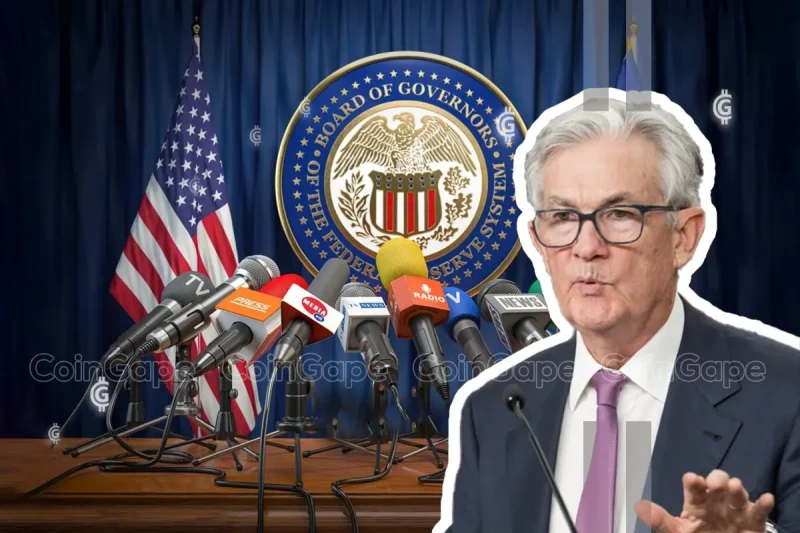The Federal Reserve lowered the target range for the federal funds rate by 50 basis points on Wednesday. This action brings the rate to a new range of 4.75% to 5.00%, which is the first decline in four years. The decision is in line with the Fed’s policy of ensuring that inflation is kept in check without jeopardising the stability of the economy.
Federal Reserve’s Justification for Rate Cut
The Federal Reserve announced the rate cut citing recent economic figures that pointed to growth at a steady pace, but with some moderation. Although job creation has slowed down and the unemployment rate has risen marginally, inflation is slowly moving towards the Fed’s target of 2%.
The central bank considers the outlook for the economy as still cloudy however, it views the risks to achievement of the dual mandate as evenly split.
Chair Jerome Powell noted that this decision is a small step to fine-tune policy to help maintain economic conditions. He told the market that the Fed is still determined to meet its employment and inflation targets. In addition, the Fed is likely to go on reviewing the data flow and may change the course of its policy should new economic circumstances occur.
Powell’s Perspective on the Economic Landscape
Jerome Powell noted that the US economy is healthy, and the economic growth is expected to remain strong. Inflation is gradually coming down while the labor market remains robust even as job creation slows down.
The Fed Chair emphasized that the Fed’s goal is to return inflation to its target level without causing a sharp increase in unemployment, which is typical for disinflation.
The head of the central bank also added that the low interest rate environment that has been observed in the previous years is not expected to continue in the future. Powell admitted that the neutral rate – the interest rate that does not stimulate or hinder economic growth– could be much higher now but it is still unclear just how high it is. This shift is a break from previous monetary policies that have involved extended periods of near-zero interest rates.
Reactions to the Federal Reserve’s Decision
However, the rate cut was not supported by all members of the Federal Open Market Committee (FOMC) as the Fed Governor Michelle Bowman voted for a 25 basis point cut. Nevertheless, the Fed Chair stressed that there was consensus within the committee regarding the need for policy change. He stressed that the decision would be taken from one meeting to another, considering the current and forecasted trends.
Some of the investors have been supportive but many of them have raised their concerns that the 50 basis points cut was too much. Financial markets expressed their reaction with keen interest with the S&P 500 and the Dow Jones setting new highs after the announcement. However, concerns over the size and the time of the cut diminished the rally, as some think that the economy is still quite healthy and did not necessitate such a deep cut.
Yes, that’s what the stock market wanted from the #FOMC This is the S&P 500. pic.twitter.com/O6FKSdRfEY
— John Authers (@johnauthers) September 18, 2024
Moving forward, the Federal Reserve’s Summary of Economic Projections (SEP) indicates that interest rates may fall even more in 2025 and 2026. According to the SEP, rates could be at 4.25% to 4.5% by the end of this year with more possible cuts to follow. According to its current forecasts, the central bank expects interest rates to reach 2.9% by 2026, which may suggest a further softening of monetary policy.
While the Fed decided to decrease rates, Jerome Powell noted that this does not mean that the same trend will persist in the future. He emphasized that each decision will be made based on current and future economic conditions and information. Thus, the market participants should not anticipate the central bank to deliver similar decisions at the subsequent meetings.
Labor Market and Inflation Considerations
The Federal Reserve has also paid keen interest to the labor market leading to this rate cut. As the Fed Chair pointed out, although job creation has decelerated in the past few months, the labor market is still very close to full capacity. However, the Fed is keeping a close eye on these trends, as a sharp decline in job growth could be indicative of an economic decline.
Concurrently, inflation remains the primary concern for the Federal Open Market Committee (FOMC). The Fed Chair stated that, according to the PCE price index, inflation is projected to decline to 2.2% in August from 2.5% in July. This action takes inflation rate nearer to the Fed’s 2% target, thus strengthening the Fed’s stance on the policy adjustment.
Despite the positive signs, some experts worry that the Fed might be acting too quickly. They argue that the U.S. economy remains robust, with unemployment still relatively low, and that further easing could spark unnecessary risks, such as asset bubbles or overheating in certain sectors. Nevertheless, Jerome Powell maintained that the Fed’s approach has been patient and that its decision to cut rates reflects confidence in inflation’s steady decline.
The post Federal Reserve Meeting Major Highlights and Key Points appeared first on CoinGape.

